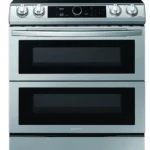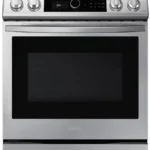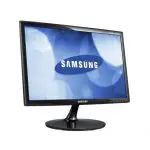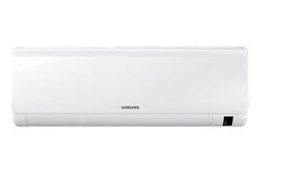
 Air conditioner
Air conditioner
User manual
AC***BNLDCH, AC***BNHDCH
Thank you for purchasing this Samsung air conditioner.
Before operating this unit, please read this user manual carefully and retain it for future reference.
ENERGY STAR qualified model only
- Proper sizing and installation of equipment are critical to achieving optimal performance. Split system air conditioners and heat pumps (excluding ductless systems) must be matched with appropriate coil components to meet ENERGY STAR criteria. Ask your contractor for details or visit www.energystar.gov.
Qualified model list (Indoor/Outdoor):
AC009BNHDCH / AC009BXADCH
AC009BNLDCH / AC009BXADCH
AC012BNHDCH / AC012BXADCH
AC018BNHDCH / AC018BXADCH
AC024BNHDCH / AC024BXADCH

Safety Information
California Proposition 65 Warning (US)
 WARNING
WARNING
Before using your new air conditioner, please read this manual thoroughly to ensure that you know how to safely and efficiently operate the extensive features and functions of your new appliance. Because the following operating instructions cover various models, the characteristics of your air conditioner may differ slightly from those described in this manual. If you have any questions, call your nearest contact center or find help and information online at www.samsunghvac.com.
 WARNING
WARNING
Hazards or unsafe practices may result in severe personal injury or death.
 CAUTION
CAUTION
Hazards or unsafe practices that may result in minor personal injury or property damage.
![]() Follow directions.
Follow directions.
![]() Do NOT attempt.
Do NOT attempt.
![]() Make sure the machine is grounded to prevent electric shock.
Make sure the machine is grounded to prevent electric shock.
![]() Cut-off the power supply.
Cut-off the power supply.
![]() Do NOT disassemble.
Do NOT disassemble.
FOR INSTALLATION
 WARNING
WARNING
![]() Use the power line with the power specifications of the product or higher and use the power line for this appliance only. In addition, do not use an extension line.
Use the power line with the power specifications of the product or higher and use the power line for this appliance only. In addition, do not use an extension line.
- Extending the power line may result in electric shock or fire.
- Do not use an electric transformer. It may result in electric shock or fire.
- If the voltage/frequency/rated current condition is different, it may cause a fire.
 The installation of this appliance must be performed by a qualified technician or service company.
The installation of this appliance must be performed by a qualified technician or service company. - Failing to do so may result in electric shock, fire, explosion, problems with the product, or injury and may also void the warranty on the installed product.
Install a switch and circuit breaker dedicated to the air conditioner. - Failing to do so may result in electric shock or fire.
Fix the outdoor unit firmly so that the electric part of the outdoor unit is not exposed. - Failing to do so may result in electric shock or fire, explosion, or problems with the product.
 Do not install this appliance near a heater, inflammable material. Do not install this appliance in a humid, oily, or dusty location, in a location exposed to direct sunlight and water (raindrops). Do not install this appliance in a location where gas may leak.
Do not install this appliance near a heater, inflammable material. Do not install this appliance in a humid, oily, or dusty location, in a location exposed to direct sunlight and water (raindrops). Do not install this appliance in a location where gas may leak. - This may result in electric shock or fire.
Never install the outdoor unit in a location such as on a high external wall where it could fall. - If the outdoor unit falls, it may result in injury, death or property damage.
 This appliance must be properly grounded. Do not ground the appliance to a gas pipe, plastic water pipe, or telephone line.
This appliance must be properly grounded. Do not ground the appliance to a gas pipe, plastic water pipe, or telephone line. - Failure to do so may result in electric shock, fire, an explosion, or other problems with the product.
 CAUTION
CAUTION
![]() Install your appliance on a level and hard floor that can support its weight.
Install your appliance on a level and hard floor that can support its weight.
- Failing to do so may result in abnormal vibrations, noise, or problems with the product.
Install the draining hose properly so that water is drained correctly. - Failing to do so may result in water overflowing and property damage. Avoid adding drain to waste pipes as odors may arise in the future.
When installing the outdoor unit, make sure to connect the draining hose so that draining is performed correctly. - The water generated during the heating operation by the outdoor unit may overflow and result in property damage. In particular, in winter, if a block of ice falls, it may result in injury, death, or property damage.
FOR POWER SUPPLY
 WARNING
WARNING
![]() When the circuit breaker is damaged, contact your nearest service center.
When the circuit breaker is damaged, contact your nearest service center.
![]() Do not pull or excessively bend the power line. Do not twist or tie the power line. Do not hook the power line over a metal object, place a heavy object on the power line, insert the power line between objects, or push the power line into the space behind the appliance.
Do not pull or excessively bend the power line. Do not twist or tie the power line. Do not hook the power line over a metal object, place a heavy object on the power line, insert the power line between objects, or push the power line into the space behind the appliance.
- This may result in electric shock or fire.
 CAUTION
CAUTION
 When not using the air conditioner for a long period of time or during a thunder/lightning storm, cut the power at the circuit breaker.
When not using the air conditioner for a long period of time or during a thunder/lightning storm, cut the power at the circuit breaker. - Failing to do so may result in electric shock or fire.
FOR USING
 WARNING
WARNING
![]() If the appliance is flooded, please contact your nearest service center.
If the appliance is flooded, please contact your nearest service center.
- Failing to do so may result in electric shock or fire.
If the appliance generates a strange noise, a burning smell or smoke, cut off the power supply immediately and contacts the nearest service center. - Failing to do so may result in electric shock or fire.
 In the event of a gas leak (such as propane gas, LP gas, etc.), ventilate immediately without touching the power line. Do not touch the appliance or power line.
In the event of a gas leak (such as propane gas, LP gas, etc.), ventilate immediately without touching the power line. Do not touch the appliance or power line. - Do not use a ventilating fan.
- A spark may result in an explosion or fire.
To reinstall the air conditioner, please contact your nearest service centre. - Failing to do so may result in problems with the product, water leakage, electric shock, or fire.
- A delivery service for the product is not provided. If you reinstall the product in another location, additional construction expenses and an installation fee will be charged.
- Especially, when you wish to install the product in an unusual location such as in an industrial area or near the seaside where it is exposed to the salt in the air, please contact your nearest service center.
 Do not touch the circuit breaker with wet hands.
Do not touch the circuit breaker with wet hands. - This may result in electric shock.
Do not turn the air conditioner off with the circuit breaker while it is operating. - Turning the air conditioner off and then on again with the circuit breaker may cause a spark and result in electric shock or fire.
 After unpacking the air conditioner, keep all packaging materials well out of the reach of children, as packaging materials can be dangerous to children.
After unpacking the air conditioner, keep all packaging materials well out of the reach of children, as packaging materials can be dangerous to children. - If a child places a bag over its head, it may result in suffocation.
Do not touch the front panel with your hands or fingers during the heating operation. - This may result in electric shock or burns.
Do not insert your fingers or foreign substances into the outlet when the air conditioner is operating or the front panel is closing. - Take special care that children do not injure themselves by inserting their fingers into the product.
Do not insert your fingers or foreign substances into the air inlet/outlet of the air conditioner. - Take special care that children do not injure themselves by inserting their fingers into the product.
Do not strike or pull the air conditioner with excessive force. - This may result in fire, injury, or problems with the product.
Do not place an object near the outdoor unit that allows children to climb onto the machine. - This may result in children seriously injuring themselves.
Do not use this air conditioner for long periods of time in badly ventilated locations or near infirm people. - Since this may be dangerous due to a lack of oxygen, open a window at least once an hour.
 If any foreign substance such as water has entered the appliance, cut off the power supply and contact the nearest service center.
If any foreign substance such as water has entered the appliance, cut off the power supply and contact the nearest service center. - Failing to do so may result in electric shock or fire.
 Do not attempt to repair, disassemble, or modify the appliance yourself.
Do not attempt to repair, disassemble, or modify the appliance yourself. - Do not use any fuse (such as copper, steel wire, etc.)other than the standard fuse.
- Failing to do so may result in electric shock, fire, problems with the product, or injury.
CAUTION
 Do not place objects or devices under the indoor unit.
Do not place objects or devices under the indoor unit. - Water dripping from the indoor unit may result in fire or property damage.
Check that the installation frame of the outdoor unit is not broken at least once a year. - Failing to do so may result in injury, death, or property damage.
 Do not stand on top of the appliance or place objects (such as laundry, lighted candles, lighted cigarettes, dishes, chemicals, metal objects, etc.) on the appliance.
Do not stand on top of the appliance or place objects (such as laundry, lighted candles, lighted cigarettes, dishes, chemicals, metal objects, etc.) on the appliance. - This may result in electric shock, fire, problems with the product, or injury.
Do not operate the appliance with wet hands.
This may result in electric shock. Do not spray volatile material such as insecticide onto the surface of the appliance. - As well as being harmful to humans, it may also result in electric shock, fire or problems with the product.
Do not spray volatile material such as insecticide onto the surface of the appliance. - As well as being harmful to humans, it may also result in electric shock, fire or problems with the product.
Do not drink the water from the air conditioner. - The water may be harmful to humans.
Do not apply a strong impact to the remote controller and do not disassemble the remote controller.
Do not touch the pipes connected with the product. - This may result in burns or injury.
Do not use this air conditioner to preserve precision equipment, food, animals, plants or cosmetics, or for any other unusual purposes. - This may result in property damage.
Avoid directly exposing humans, animals, or plants to the airflow from the air conditioner for long periods of time. - This may result in harm to humans, animals, or plants.
This appliance is not intended for use by persons (including children) with reduced physical, sensory or mental capabilities, or lack of experience and knowledge unless they have been given supervision or instruction concerning the use of the appliance by a person responsible for their safety. Children should be supervised to ensure that they do not play with the appliance.
FOR CLEANING
 WARNING
WARNING
![]() Do not clean the appliance by spraying water directly onto it.
Do not clean the appliance by spraying water directly onto it.
Do not use benzene, thinner, alcohol, or acetone to clean the appliance.
- This may result in discoloration, deformation, damage, electric shock, or fire.
Before cleaning or performing maintenance, cut off the power supply and wait until the fan stops. - Failing to do so may result in electric shock or fire.
CAUTION
 Take care when cleaning the surface of the heat exchanger of the outdoor unit since it has sharp edges.
Take care when cleaning the surface of the heat exchanger of the outdoor unit since it has sharp edges. - To avoid cutting your fingers, wear thick cotton gloves when cleaning it.
- This should be done by a qualified technician please contact your installer or service center.
 Do not clean the inside of the air conditioner by yourself.
Do not clean the inside of the air conditioner by yourself. - For cleaning inside the appliance, contact your nearest service center.
- When cleaning the internal filter, refer to the descriptions in the ‘Cleaning and Maintaining’ section.
- Failure to do may result in damage, electric shock, or fire.
- Make sure to prevent any injury from sharp edges of the surface when handling the heat exchanger.
Indoor Unit Overview
Congratulations on the purchase of the air conditioner. We hope you enjoy the features of your air conditioner and stay cool or warm with optimal efficiency.
Please read the user manual to get started and to make the best use of the air conditioner.
AC***BNLDCH
 |
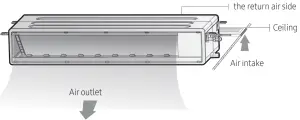 |
![]() NOTE
NOTE
- Your air conditioner and the display may look slightly different from the illustration shown above depending on your model.
Cleaning the Air Conditioner
Cleaning the air filter
For optimal performance clean the filter periodically. For your safety, when cleaning the filter make sure the unit is off.
When cleaning the filter, make sure to cut off the power supply. A washable foam-based Air filter captures large particles from the air. The filter is cleaned with a vacuum or by hand washing.
AC***BNLDCH
- Slide out the Air filter on the rear side panel to the right side.

- Clean the Air filter with a vacuum cleaner or soft brush. If dust is too heavy, then rinse it with running water and dry it in a ventilated area.
 • For best conditions, repeat every two weeks.
• For best conditions, repeat every two weeks.
• If the Air filter dries in a confined (or humid) area, odors may generate. If it occurs, re-clean and dry it in a ventilated area.
- Insert the Air filter back in its original position.

![]() NOTE
NOTE
- The illustration shown above may differ from yours depending on your model.
- After cleaning the filter, press the Filter Reset button on the remote control for 2 seconds to reset the filler schedule. The filter sign indicator will be on for cleaning time.
- AC***BNHDCH model does not provide a filter by default.
Maintaining the Air Conditioner
If the air conditioner will not be used for an extended period of time, dry the air conditioner to maintain it in the best conditions.
- Dry the air conditioner thoroughly by operating in Fan mode for 3 to 4 hours and then turn off the power.
There may be internal damage if moisture is left in components. - Before using the air conditioner again, dry the inner components of the air conditioner again by running in Fan mode for 3 to 4 hours. This helps remove odors that may have been generated from dampness.
Periodical checks
Refer to the following chart to maintain the air conditioner properly.
| Type | Description | Monthly | Every4 month Once a | year |
| Indoor unit | Clean the air filter (1). | • | ||
| Clean the condensate drain pan (2). | • | |||
| Thoroughly clean the heat exchanger (2). | • | |||
| Clean the condensate drain pipe (2). | • | |||
| Replace the remote control batteries (1). | • | |||
| Outdoor unit | Clean the heat exchanger on the outside of the unit (2). | • | ||
| Clean the heat exchanger on the inside of the unit (2). | • | |||
| Clean the electric components with jets of air (2). | • | |||
| Verify that all the electric components are firmly tightened (2). | • | |||
| Clean the fan (2). | • | |||
| Verify that all the fan assembly is firmly tightened (2). | • | |||
| Clean the condensate drain pan (2). | • |
![]() NOTE
NOTE
- The checks and maintenance operations described above are essential to guarantee the efficiency of the air conditioner. The frequency of these operations may vary depending on the characteristics of the area, the amount of dust, etc.
1. The above-mentioned operations should be performed more frequently if the area of installation is very dusty.
2. These operations must always be performed by qualified personnel. For more detailed information, refer to Installation Manual.
Internal protections via the unit control system
The air conditioner control system has internal protections for user comfort and system faults.
| Type | Description |
| Cold air prevention | While in heat mode, the internal fan will not operate while the indoor unit coil is warming up to prevent the circulation of cold air. |
| De-ice cycle | While the heat pump defrosts, the internal fan will not operate to prevent the circulation of cold air. |
| Anti-protection of internal battery | The compressor will be off to protect the internal battery when the air conditioner operates in Cool mode. |
| Protect compressor | The air conditioner does not start operating immediately to protect the compressor of the outdoor unit after it has been started. |
![]() NOTE
NOTE
- If the heat pump is operating in Heat mode, the de-ice cycle is actuated to remove frost from an outdoor unit that may have been deposited at low temperatures.
- The internal fan is switched off automatically and restarted only after the de-ice cycle is completed.
- When the de-ice cycle is operating, it may generate a strange sound. It is a normal operation for product safety.
Troubleshooting
Refer to the following chart if the air conditioner operates abnormally. This may save time and unnecessary expense.
| Problem | Solution |
| The air conditioner does not operate immediately after it has been restarted. |
• Because of the protective mechanism, the appliance does not start operating immediately to keep the unit from overloading. The air conditioner will start in 3 minutes. |
| The air conditioner does not operate atall. |
• Check whether the power is turned on, and then operate the air conditioner again. • Check whether the auxiliary power switch (MCCB, ELB) is turned on. • If the auxiliary power switch (MCCB, ELB) is turned off, the air conditioner does not work although you press the  (Power) button. (Power) button.• When you clean the air conditioner or do not use it for an extended period of time, turn off the auxiliary power switch (MCCB, ELB). • After the air conditioner is not used for an extended period of time, be sure to turn on the auxiliary power switch (MCCB, ELB) 6 hours before starting operation. • The auxiliary power switch (MCCB, ELB) is sold separately. • Make sure that an auxiliary power switch (MCCB, ELB) is installed in the distribution box inside the building. • If the air conditioner is turned off by the Timed off function, turn on the air conditioner again by pressing the  (Power) button. (Power) button. |
| The temperature does not change. | • Check whether the Fan mode is running. In the Fan mode, the air conditioner controls the set temperature automatically, and you cannot change the set temperature. |
| Warm air does not come out of the air conditioner. | • Check whether the outdoor unit is designed for cooling only. In this case, warm air does not come out although you select the Heat mode. • Check whether the remote control is designed only for cooling only. Use a remote control that supports both cooling and heating. |
| The fan speed does not change. | • Check whether the Auto or Dry mode is running. In these modes, the air conditioner controls the fan speed automatically, and you cannot change the fan speed. |
| The wireless remote control does not operate. | • Check whether the batteries are discharged. Replace the batteries with new ones. • Make sure that nothing is blocking the remote control sensor. • Check whether any strong lighting sources are near the air conditioner. Strong light which comes from fluorescent bulbs or neon signs may interfere with the remote control. |
| The wired remote control does not operate. | • Check whether the |
| The air conditioner is not turned on or off immediately with wired remote control. | • Check whether the wired remote control is set for group control. In this case, the air conditioners connected to the wired remote control are turned on or off sequentially. This operation takes up to 32 seconds. |
| The Timed on/off function does not operate. | • Check whether you pressed the |
| The indoor unit display blinks continuously. | • Turn on the air conditioner again by pressing the (Power) button. (Power) button.• Turn off and then turn on the auxiliary power switch, and then turn on the conditioner. • If the indoor unit display is still blinking, contact a service center. |
| I want to get cooler air. | • Operate the air conditioner with an electric fan to save energy and enhance the cooling efficiency. |
| The air is not cool warm enough. | • In the Cool mode, cool air does not come out if the set temperature is higher than the current temperature. – Remote control: Press the Temperature button repeatedly until the set temperature [minimum: 64°F(18°C)] is set to lower than the current temperature. • In the Heat mode, warm air does not come out if the set temperature is lower than the current temperature. – Remote control: Press the Temperature button repeatedly until the set temperature [maximum: 86°F(30°C)] is set to higher than the current temperature. • Both cooling and heating do not operate in the Fan mode. Select the Cool, Heat, Auto, or Dry mode. • Check whether the air filter is blocked with dirt. A dusty filter may decrease the cooling and heating efficiencies. Clean the air filter frequently. • If a cover is on the outdoor unit or any obstacle is present near the outdoor unit, remove them. • Install the outdoor unit in a well-ventilated place. Avoid places exposed to direct sunlight or close to a heating appliance. • Place sunscreen over the outdoor unit to protect it from direct sunlight. • If the indoor unit is installed in a place exposed to direct sunlight, pull the curtains on the windows. |
| The air is not cool or warm enough. |
• Close the windows and doors to maximize the cooling and heating efficiencies. • If the Cool mode is stopped and then started immediately, cool air comes out after about 3 minutes to protect the compressor of the outdoor unit. • When the Heat mode is started, warm air does not come out immediately to prevent cool air from coming out at the beginning. • If the refrigerant pipe is too long, the cooling and heating efficiencies may be decreased. Avoid exceeding the maximum pipe length. |
| The air conditioner makes strange noises. | • In certain conditions [especially, when the outdoor temperature is lower than 68°F(20°C)], a hissing, rumbling, or splashing sound may be heard while the refrigerant is circulating through the air conditioner. This is a normal operation. • When you press the  (Power) button on the remote control, noise may be heard from the drain pump inside the air conditioner. This noise is a normal sound. (Power) button on the remote control, noise may be heard from the drain pump inside the air conditioner. This noise is a normal sound. |
| Unpleasant odors permeate the room. |
• If the air conditioner is running in a smoky area or if there is a smell entering from outside, ventilate the room properly. • If both indoor temperature and indoor humidity are high, operate the air conditioner in the Clean or Fan mode for 1 to 2 hours. • If the air conditioner has not been operated for an extended period of time, clean the indoor unit and then operate the air conditioner in the Fan mode for 3 to 4 hours to dry the inside of the indoor unit for removal of unpleasant odors. • If the air filter is blocked with dirt, clean the air filter. |
| Steam is produced on the indoor unit. | • In winter, if the indoor humidity is high, steam may be produced around the air outlet while the defrost function is running. This is a normal operation. |
| The outdoor unit fan continues to operate when the air conditioner is turned off. | • When the air conditioner is turned off, the outdoor unit fan may continue to operate to reduce noise of the refrigerant gas. This is a normal operation. |
| Water drops from the piping connections of the outdoor unit. |
• Condensation may develop due to the difference in temperature. This is a normal condition. |
| Steam is produced on the outdoor unit. |
• In winter, when the air conditioner runs in Heat mode, the frost on the heat exchanger melts and steam may be produced. This is a normal operation, neither product malfunction nor a fire. |
Operation Features
Operating temperature and humidity
When using the air conditioner follow the operating temperature and humidity ranges.
Indoor unit / Outdoor unit : AC***BN*DCH / AC***BXADCH
| Mode | Indoor temperature |
Outdoor temperature |
Indoor humidity | If out of conditions |
| Cooling | 64°F to 90°F (18°C to 32°C) |
0°F to 122°F (-18°C to 50°C) | 80% or less | Condensation may occur on the indoor unit with the risk to have either water blowing off or drops on the floor. Internal protection triggers and the air conditioner will stop. |
| Drying | 64°F to 90°F (18°C to 32°C) |
(18°C 0°F to 122°F (-18°C to 50°C) | or less | |
| Heating | 86°F or less (30°C or less) |
AC009/012/018/024BN*DCH -13°F to 75°F (-25°C to 24°C) ACO30/036/042/048BN*DCH -4°F to 75°F (-20°C to 24°C ) |
– | Internal protection triggers and the air conditioner will stop. |
Indoor unit / Outdoor unit : AC***BN*DCH / AJ***BX**CH
| Mode | Indoor temperature | Outdoor temperature | Indoor humidity | If out of conditions |
| Cooling | 64°F to 90°F (18°C to 32°C) |
Depending on the outdoor unit specifications | 80% or less | Condensation may occur on the indoor unit with the risk to have either water blowing off or drops on the floor. Internal protection triggers and the air conditioner will stop. |
| Drying | 64°F to 90°F (18°C to 32°C) |
80% or less | ||
| Heating | 86°F or less (30°C or less) |
Internal protection triggers and the air conditioner will stop. |
 CAUTION
CAUTION
- If you use the air conditioner at a relative humidity above 80%, it may cause a formation of condensation and a leakage of water on the floor.
- The standardized temperature for heating is 45˚F (7˚C). If the outdoor temperature drops to 32˚F (0˚C) or below, the heating capacity can be reduced depending on the temperature condition. If the cooling operation is used at over 90˚F (32˚C) (indoor temperature), it does not cool at its full capacity.
- If the indoor unit is out of the operating temperature and humidity range, the safety device may operate and the air conditioner may stop.

QUESTIONS OR COMMENTS?
| COUNTR | CALL | OR VISIT US ONLINE AT |
| AMERICA | 888-699-6067 (Samsung HVAC) | www.samsunghvac.com |
